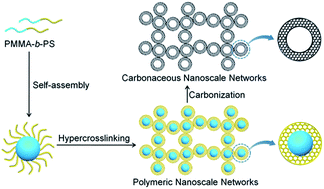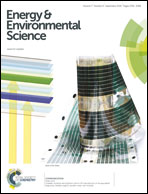Fabrication of novel polymeric and carbonaceous nanoscale networks by the union of self-assembly and hypercrosslinking†
Abstract
Constructing three-dimensionally interconnected nanoscale networks is critical for porous materials to achieving enhanced pore accessibility and fast mass transport. Currently, development of facile and effective methods for fabrication of three-dimensional polymeric and carbonaceous networks with a well-defined nanostructure is still challenging. Herein, we present a successful development of a novel class of polymeric and carbonaceous nanoscale networks based on the union of self-assembly and hypercrosslinking. A poly(methyl methacrylate)-b-polystyrene (PMMA-b-PS) diblock copolymer was first self-assembled into uniform PMMA@PS core–shell nanospheres, and then the resulting nanospheres were used as building blocks to construct polymeric nanoscale networks by hypercrosslinking. Due to their hypercrosslinked framework, the as-prepared polymeric nanoscale networks were further transformed into carbonaceous nanoscale networks after carbonization. The resulting nanoporous materials have well-developed three-dimensionally interconnected hierarchical porosity and thus hold great promise in many applications, for example, as CO2 capture materials and as supercapacitor electrodes.


 Please wait while we load your content...
Please wait while we load your content...